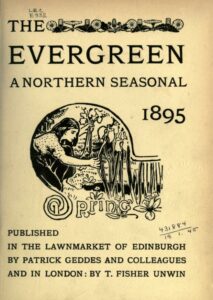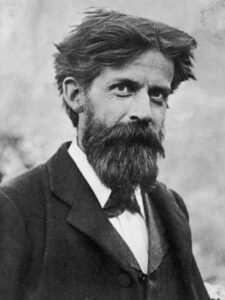Patrick Geddes’ Expression of Art in Nature
Patrick Geddes and Life and Its Sciences;
Art Expressed in Nature and Biology
© Copyright 2017 Michelle Oliveri, Ryerson University

Introduction:
The text “Life and Its Sciences” published by Patrick Geddes in The Evergreen; Volume 1 labelled as the Spring edition written in the 19th century represents biology as the art of nature. Through the lens of art and nature, there are developments found in Geddes’ work that have contributed to the rebuilding of natural environments established through environmental planning.
Geddes’ “Life and Its Sciences” is a text that compares the purpose of different branches of science, such as zoology, physiology, and necrology, and how they contribute to a larger image of how the world revolves around science while connecting them to nature. Geddes’ establishes an emphasis on biology because it evolves from studying nature. The connection to nature is based on studying natural life, behaviour, and variety of sex and species found within different ecosystems. There is a need to recover the ecosystems that are being harmed by seasons and failed environmental planning. The relation to art stems from the beauty found within ecosystems that are thriving through growth and development and housing a variety of species protecting them from human threats. Geddes’ also focuses on the revolution of environmental planning by teaching students everything that is currently known, resulting in developments in restoring and preserving ecosystem, and the art of nature.
Art is not viewed in “Life and Sciences” as a physical object that can be held, instead it refers to an ecosystem that fuels current and future life, which can be seen when looking beyond the human-controlled city. Art is expressed through natural life and the ability to restore the ecosystems through environmental planning to encourage the introduction of new species to the variety already protected. The ecosystems need to be strong enough to survive against the threats that challenge their existence. Geddes’ declares that each season brings something towards natural life whether it is in a positive or negative way. Spring, Summer and Autumn impact ecosystems in a positive way through encouraging growth of flowers and fruits which feed many species helping them survive, and greenery which contributes to the overall “art” of nature. Winter has the biggest negative impact on natural life through damage from harsh weather and food restrictions, therefore increasing the need to protect natural life (Geddes 33).
Biology; the Study of Life:
Connecting Nature to Zoology, Physiology, and Necrology
“Life and Its Sciences” introduces the topic of nature through a comparison between biology and other branches including zoology, physiology, and necrology. This comparison is brought on to be significant in the text produced by Geddes because they all relate to studying life in various forms. Zoology, physiology, and necrology are referenced to express the similarities they hold to biology proving the significance of how biology should be considered equal to other branches of science. Zoology is referenced to be the study of structure and habitats in correspondence to the ecosystems of living and nonliving species. Geddes refers to zoologists as “mad huntsman” in “Life and Its Sciences” because they intently research species that are both living or nonliving (Geddes 30). Physiology is defined as understanding how living organisms’ function and the individual parts of their bodies, in which Geddes refers to them as conducting research for the purpose of analysis of the species. Necrology is the last branch of science that Geddes references which is the study of dead organisms and is referred to as essential to understand the ecosystems (Geddes 31).
A History of Patrick Geddes and his Contributions:

Patrick Geddes identifies as a biologist, an environmentalist, and an ecologist due to his many works published between the 18th century to the late 19th century. Geddes has influenced many other biologists through the teaching and works that were published between this time frame. There have been multiple theories developed by Geddes’ that have contributed to influencing other ecologists in the late 19th century, such as environmental planning theories focused on improving land use and reforestation (Mather 48). The environmental planning theory holds the desire to focus on saving ecosystems, rather than making further mistakes that threat their existence. The environmental planning theory develops the concept in “Life and Its Sciences” other branches of science such as zoology, physiology, and necrology should be considered equal (Geddes 30-31). The expansion of knowledge contributes to the development of environmental planning and expanding and restoring already existing ecosystems.
Geddes’ believes that the city is a part of nature which refers to the environmental planning that can impact or harm ecosystems. He refers to the “organic whole” which indicate the coexistence of the city, human life, and ecosystems to create the definition of nature and variations in ecosystems (Spirn 41). It is classified as “art” when both humans and natural life can coexist in the same area without harming and eliminating the existence of the other. Reforestation and restoration are examples of Geddes’ focus on coexistence between human life and nature.
Alongside the environmental planning theory that Geddes’ has formed additional theories including the geotechnic theory of considering both human and natural life within an ecosystem (Young 33). Restoration of ecosystems through integrating them within the city, instead of treating human life and natural life as different species (Young 34). As Geddes’ illustrates in “Life and Its Sciences,” humans and natural life are equal under the classification of biology because they are both living species and therefore benefit from reforestation and restoration processes. The coexistence of humans and natural life contributes to the definition of art in nature, referenced by Geddes.
Art and Its Connection to Nature:
Art is not referred to by Geddes in the artistic sense of a physically created object that is subjective to an individual, it is the beauty in nature once ecosystems are restored and preservation is acted upon. The flow between ecosystems allows for species to reproduce and future life can begin to expand. As future life expands, so do the ecosystems and the attention to the beauty of nature (Studholme 368). “Life and Its Sciences” expresses that through the lens of art ecosystems can be viewed as an organic whole, consisting of many factors alongside the complexity of understanding them from the perspective of biology.
Natural life expands beyond the coexistence of human and nature. Throughout “Life and Its Sciences,” Geddes considers the behaviours of different species, and the variety of sex and types of species that exist within a single ecosystem (Geddes 30). The correlation of each of these varieties allow for an expansion of an ecosystem because there is room for reproduction and growth, with the assistance from environmental planning. The beauty of various species found within a single ecosystem corresponds to the art focused lens to the art in nature. With the expansion of an ecosystem to make room for various species, the survival mechanisms are altered to protect against harm and ensure survival. This evolution allows the species to live longer and therefore multiply and migrate to various other ecosystems and contributing to reproduction. Alternately, expansion may also cause reproduction between different species and also contribute to reproduction, contributing to the art and beauty found within ecosystems. This therefore emphasizes the importance of Geddes’ reference to environmental planning because there is a benefit to biology when this occurs. Benefits include future studies and develops being made to already existing studies, and progression with understanding ecosystems. Future possibilities for studies also contribute to the point raised by Geddes in “Life and Its Sciences” that teachers must teach students as much as they know about biology for there to be progression within the field, based on already existing studies and information.
Geddes indicates that alongside the various species that are found within an ecosystem, there are also various sexes allowing for reproduction and expansion. Geddes believes that with the reforestation that is planned through a focus on environmental planning, there will be an evolution within the ecosystems allowing for reproduction (Spirn 44). Nature does not define reproduction as being limited to the same organisms, but instead is sometimes possible among similar organisms conveyed in “Life and Its Sciences” through the connection to studying natural life in terms of various species and sexes (Geddes 30). Understanding the various species found within individual ecosystems is essential to understanding the behaviour of each of the species. Geddes states that species behaviours derive from human life and natural life abilities to coexist (Spirn 39). If there is a threat against the ecosystem, the species will act in a way to protect themselves and their homes. Applied to the definition of biology studying the various species and their relations within an ecosystem, their behaviours are studied to change in terms of reproduction. Reproduction relates to the art view applied to “Life and Its Sciences” because the evolution of species within ecosystems emphasize the growth and developments made during restoration and creating an organic whole (Spirn 41).
Conclusion:
The lens of art and nature are applied to the developments referred to in Geddes’ work, including “Life and Its Sciences.” The emphasis on ecosystems being rebuilt and protected through careful environmental planning corresponds with Geddes’ background of environmental planning theories expressed in his other works. The emphasis on the importance the biology has on ecosystems and further studies is compared to other branches of science such as zoology, physiology, and necrology. There is a comparison among these fields because they all hold the same purpose of understanding living and nonliving life and the ecosystems in which they lived and how it influenced evolution and reproduction. The critical view of this topic focuses on art because understanding living and nonliving life creates opportunities for restoration and future life therefore contributing to Geddes’ theory of the organic whole. The organic whole is the major determinate to seeing the developments made through environmental planning and therefore creates a new world for the species, which is understood through viewing nature through an art perspective.
Works cited
Geddes, Patrick E. “Life and Its Sciences.” The Evergreen, 1895, Vol. 1, pp. 28-37.
Mather, Alexander S. “Geddes, Geography and Ecology: The Golden Age of Vegetation
Mapping in Scotland.” Scottish Geographical Journal, vol. 115, no. 1, Jan. 1999, pp. 35-52, doi:10.1080/00369229918737056.
Spirn, Anne W. “Urban Nature and Human Design: Renewing the Great Tradition.” Journal of Planning Education and Research, vol. 5, no. 1, 1 Oct. 1985, pp. 39-51, doi:10.1177/0739456X8500500106.
Studholme, Maggie. “Patrick Geddes and the History of Environmental Sociology in Britain: A Cautionary Tale.” Journal of Classical Sociology, vol. 8, no. 3, 1 Aug. 2008, pp. 367-91, doi:10.1177/1468795X08092384.
Young, Robert F. “Free cities and regions” – Patrick Geddes’ theory of planning.” Landscape and Urban Planning, vol. 166, 6 May 2017, pp. 27-36, doi:10.1016/j.landurbplan.2017.03.007.
Images in this online exhibit are either in the public domain or being used under fair dealing for the purpose of research and are provided solely for the purposes of research, private study, or education.
